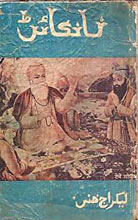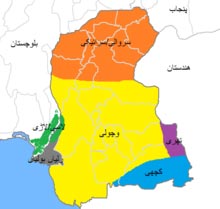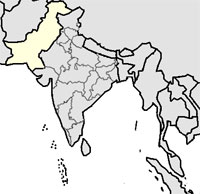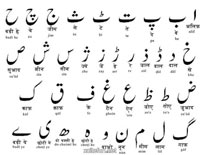Sindhi Language

 Introduction
IntroductionSindhi is the language of the Sindh region of Pakistan. It is estimated that about 34 million people in Pakistan speak this language. Being the third most spoken language in all of Pakistan, it is the official language of the province of Sindh.There are 3 million Sindhi speaking people in India mainly in Kutch. Hindu Sindhis who migrated from Sindh and settled in India after partition are the rest.
It is the mother tongue of a vast majority of the Sindhi diaspora worldwide. It has the credit of being the only language used by the government of Pakistan for issuing national identity cards to its citizens other than Urdu. However, among the modern Indian languages, Sindhi is the only language which is not an official language of any particular state. It is an Indo-Aryan languag, Indo-European language family, influenced by a local version of spoken Sanskrit and by spoken form of Balochi of the adjacent province of Balochistan.
 Sindhi is mostly written in the Arabic script leading to the impression that it is
Persio-Arabic. But over seventy percent of the Sindhi vocabulary is from Sanskrit.Great scholars in this field have suggested that Sindhi is a Sanskritical language in so far as its grammatical construction is concerned and is more free from foreign elements compared to other North Indian languages. Apart from adopting very few Dravidian words, a considerable size of vocabulary has been borrowed from the Arabic and Persian languages.
Sindhi is mostly written in the Arabic script leading to the impression that it is
Persio-Arabic. But over seventy percent of the Sindhi vocabulary is from Sanskrit.Great scholars in this field have suggested that Sindhi is a Sanskritical language in so far as its grammatical construction is concerned and is more free from foreign elements compared to other North Indian languages. Apart from adopting very few Dravidian words, a considerable size of vocabulary has been borrowed from the Arabic and Persian languages.Sindhi has been described as a sweet and melodious language that sounds very much musical due to the fact that each word in Sindhi ends with a vowel. It is the language of Saints and Rishis of ancient Sindh. The beauty of Sindhi language attracted many great poets and writers and with the abundance of its vocabulary they could create a number of Sindhi literary works which has made the language rich. These works reflect the variety and quality of Sindhi life and thought.
 Origin
OriginSindhi language has evolved over a period of two millennia. Sindh valley was on the north west of undivided India and so it was the first to be affected by the frequent invasions of Greeks, Arabs, Turks, Mughals and many others. As in the case of the social life of the people, their language, Sindhi also was influenced by the invaders' respective languages.The Sindhi dialect has witnessed so big a transition over the years that historians working hard to fathom the origin of the language could come out only with varying conclusions but still the debate over its origin is going on. However it is true that even though Sindhi shares a common origin with some other languages it is an independent language, materially different from them.
 Dialects
Dialects Six major dialects are identified with regard to spoken Sindhi viz. (i) Siraiki, spoken in Siro, i.e. Upper Sindh, (ii) Vicholi, in Vicholo, Central Sindh, (iii)Lari, in Laru, i.e. Lower Sindh, (iv) Lasi, in Lasa B'elo, a part of Kohistan in
Baluchistan on the western side of Sindh, (v) Thari or Thareli, in Tharu, (the desert region on the southeast border of Sindh) and a part of the Jaisalmer district in Rajasthan and (vi) Kachhi, in the Kutch region and in a part of Kathiawar in Gujarat, on the southern side of Sindh. Vicholi, the standard dialect for all Sindhi speakers, is commonly used among the educated class and is accepted as the language of literature and education and is the administrative language in Sindh, Pakistan. The largest Sindhi-speaking city is Hyderabad, Pakistan.
Six major dialects are identified with regard to spoken Sindhi viz. (i) Siraiki, spoken in Siro, i.e. Upper Sindh, (ii) Vicholi, in Vicholo, Central Sindh, (iii)Lari, in Laru, i.e. Lower Sindh, (iv) Lasi, in Lasa B'elo, a part of Kohistan in
Baluchistan on the western side of Sindh, (v) Thari or Thareli, in Tharu, (the desert region on the southeast border of Sindh) and a part of the Jaisalmer district in Rajasthan and (vi) Kachhi, in the Kutch region and in a part of Kathiawar in Gujarat, on the southern side of Sindh. Vicholi, the standard dialect for all Sindhi speakers, is commonly used among the educated class and is accepted as the language of literature and education and is the administrative language in Sindh, Pakistan. The largest Sindhi-speaking city is Hyderabad, Pakistan.
 Literature
Literature The earliest records of the Sindhi language can only be attributed to the musical compositions of Shah Abdul Karim (1538–1625). Only a handful of Sindhi literature in poetic forms pertaining to the period prior to this is extant. Only
during the end of the 18th century, Sindhi literature started blossoming. Several literary marvels were produced. Shah Abdul Latif (1689–1752) was a Sindhi Sufi scholar, mystic, saint, poet, and musician. He is widely considered to be one of the greatest poets of the Sindhi language. His collected poems were compiled as Shah Jo Risalo, which has been translated to English, Urdu, and other languages. Sachal Sarmast (1739–1829) was another eminent Sufi rebel poet known for his staunch denouncement of religious radicals. One of the three most beloved Sufis and the greatest poets that the ancient land of Sindh has ever produced is Saami (1743-1850 AD).
The earliest records of the Sindhi language can only be attributed to the musical compositions of Shah Abdul Karim (1538–1625). Only a handful of Sindhi literature in poetic forms pertaining to the period prior to this is extant. Only
during the end of the 18th century, Sindhi literature started blossoming. Several literary marvels were produced. Shah Abdul Latif (1689–1752) was a Sindhi Sufi scholar, mystic, saint, poet, and musician. He is widely considered to be one of the greatest poets of the Sindhi language. His collected poems were compiled as Shah Jo Risalo, which has been translated to English, Urdu, and other languages. Sachal Sarmast (1739–1829) was another eminent Sufi rebel poet known for his staunch denouncement of religious radicals. One of the three most beloved Sufis and the greatest poets that the ancient land of Sindh has ever produced is Saami (1743-1850 AD). The poet Saami was more pious than poetical, yet possessing a charm of his own. Many more Sindhi poets like Bedil, his son Bekas, and Dalpat have composed several verses. Gul Mohamad introduced Persian forms of poetry replacing the native baits and Mirza Kaleech Beg followed suit to make a sizable contribution to Sindhi literature. Dayaram Gidumal, one of the two early prose writers, was a great scholar and he was famous mainly for his metaphysical writings. The other prose writer who shares the credit was Mirza Kaleech. The noted lexicographer (one who writes or compiles a dictionary) and essayist Parmanand Mewaram's essays were educative and instructional to both the young and the old alike.
The poet Saami was more pious than poetical, yet possessing a charm of his own. Many more Sindhi poets like Bedil, his son Bekas, and Dalpat have composed several verses. Gul Mohamad introduced Persian forms of poetry replacing the native baits and Mirza Kaleech Beg followed suit to make a sizable contribution to Sindhi literature. Dayaram Gidumal, one of the two early prose writers, was a great scholar and he was famous mainly for his metaphysical writings. The other prose writer who shares the credit was Mirza Kaleech. The noted lexicographer (one who writes or compiles a dictionary) and essayist Parmanand Mewaram's essays were educative and instructional to both the young and the old alike. Bherumal Meherchand, Lalchand Amardinomal, Jethmal Parsram, Acharya Gidwani, N. R. Malkani and Dr H. M. Gurbuxani were other notable writers worth mentioning.As already said the Sindhi language is ancient and rich in literature. Sindhi writers have heavily contributed to its literature in various forms. Their great works in both the forms of poetry and prose have made the language very rich. It is generally considered as one among the worlds oldest language worth mentioning.


